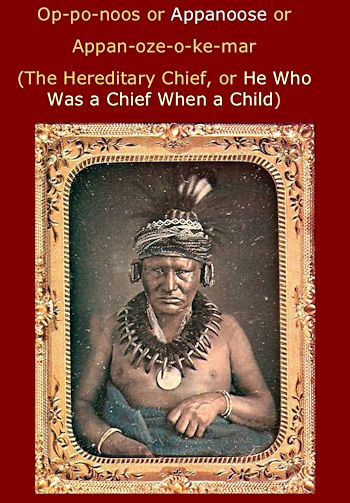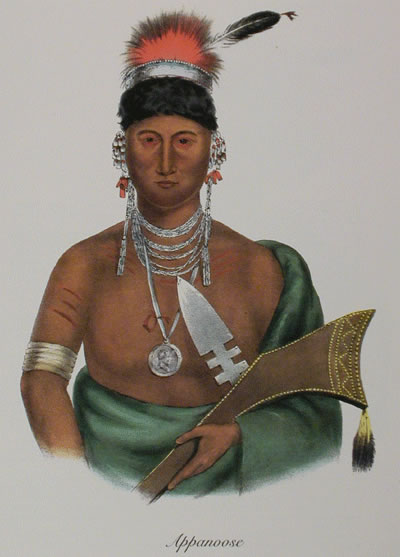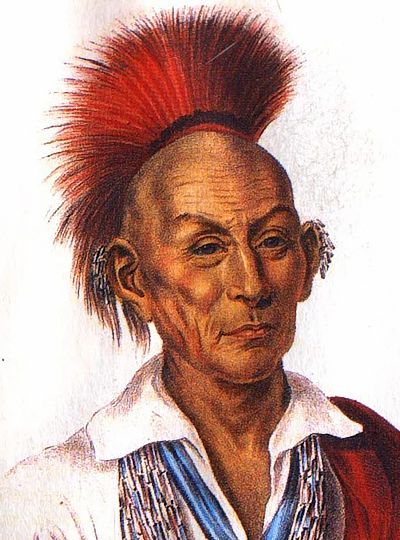Famous Sac and Fox
Chief Appanoose– Chief Appanoose (Meskwaki or Fox) became famous when he traveled to the East Coast in 1837 with the other Indian chiefs. It was on that trip, during a visit to the Massachusetts Statehouse in Boston, that Appanoose delivered what has been described as one of the most famous orations ever delivered by an Indian chief. When the Indians were required to leave Central Iowa in 1843, Chief Appanoose led his tribe to a Sauk and Fox reservation in the territory of Kansas.
Blackhawk – Famous Sauk chief who led a war against the U.S. for his homeland in Illinois in 1832. His autobiography was published in 1872. Black Hawk said, “How smooth must be the languages of the whites. When they can make the right look wrong and wrong look right.”
Saginaw Grant (born 1936) -Actor known for his roles in Breaking Bad and The Lone Ranger.
Keokuk (1767-1848) – Sauk chief who was noted for his policy of cooperation with the U.S. government which led to the Black Hawk war. Keokuk is the only Native American ever honored with a bronze bust in the U.S. Capital. His likeness has also appeared on American Currency.
Ke-shes-wa – Fox chief
Mokohoko – Leader when the removal of the Sac and Foxes from Kansas took place in 1869. Mokohoko and some 200 followers refused to go to Oklahoma.
Charles Robidoux – “Charlie” was the Chairman for the Sac and Fox Nation of Missouri from 1920 until his death in 1973.
Jim Thorpe (1888–1953) – Athlete who won gold medals in the decathlon and pentathlon at the 1912 Stockholm Olympics. He was named the world’s greatest athlete in 1950.
Wapello – Meskwaki chief, also featured in McKenney and Hall.
Anthony “Tony” Wapp – A great Sac and Fox Indian basketball star that traveled with Vic Hanson’s All Americans, the original New York Celtics, Jim Thorpe’s Indians, Olsen’s Terrible Swedes, and House of David. His basketball career extended from 1929 until 1937.
Ray Young Bear, Meskwaki writer and poet.
Sac & Fox (Sauk) Tribes:
Sac & Fox Tribe of the Mississippi in Iowa
Sac & Fox Nation of Missouri in Kansas and Nebraska
Sac & Fox Nation, Oklahoma
Sauk-Suiattle Indian Tribe, Washington
Article Index:
All the counties of Iowa were given their names by the Iowa Territorial Legislature, long before they were physically organized. Many of the counties were named for past presidents, explorers or other historical figures. Many were named for Indian chiefs or for tribes of the immediate area. Appanoose County, Iowa derived its name from Chief Appanoose, because he was an important Indian chief who had his camp along a nearby stream at one time.
 Alternate Names: Op-po-noos, Appan-oze-o-ke-mar, He Who Was A Chief When a Child, Child Chief
Alternate Names: Op-po-noos, Appan-oze-o-ke-mar, He Who Was A Chief When a Child, Child Chief
Chief Appanoose was a hereditary ruler of the Meskwaki (Fox) tribe. He was the only leading chief of the Sac & Fox tribes to be born west of the Mississippi River. He was generally regarded as a friend of the white man. The name “Appanoose” translated into English meant “chief when a child”.
Appanoose was a tall, handsome Indian, very graceful and of a commanding appearance. He was younger and subordinate to the Chiefs Keokuk and Pweshiek, but was well regarded because of his leadership qualities. He was said to be a great genereal. In fact, he was at the head of the largest band of warriors of the tribe.
At the time treaties were being made to cede this territory over to the government, the chiefs were often entertained at many of the principal eastern cities, including the national capital. Appanoose was an eloquent orator and earned the respect of the politcians with his outstanding speeches.
Chief Appanoose became famous when he traveled tothe East Coast in 1837 with the other Indian chiefs.
It was on that trip, during a visit to the Massachusetts Statehouse in Boston, that Appanoose delivered what has been described as one of the most famous orations ever delivered by an Indian chief.
He concluded his remarks by stating, “Where we live beyond the Mississippi, I am respected by all people and they consider me the tallest among them. I am happy that two great men meet and shake hands with each other.”
He then extended his hand to Governor Everett while the audience cheered and applauded. The chiefs were being wined and dined to induce them to sell their lands.
A treaty was made in Washington D.C. that year resulting in the third Black Hawk purchase of land in the eastern part of Iowa. The final purchase, including Appanoose County, was made in October 1842 when Indians from all over the state were called together to meet at Agency City, Iowa, six miles east of Ottumwa.
A brief picture is given of the clothing that Appanoose dressed in when in Washington. He had leggings of close fitted tanned deer skins from loins to ankles, trimmed with a fringe of beads and porcupine quills. His headdress consisted of a profusion of scarlet colored hair with a long black beard of a wild turkey, a silver band and richly ornamented turban.
Besides this, the chief’s ears were strung with beads and trinkets, and he boasted bracelets of brass, tin, silver and steel. He was rich with wampum strung around his neck. In the picture, his is wearing the medallion presented him by Martin Van Buren, then President of the United States.
Chief Appanoose led his tribe to a Sauk and Fox reservation in the territory of Kansas.
 When the Indians were required to leave Central Iowa in 1843, Chief Appanoose led his tribe to a Sauk and Fox reservation in the territory of Kansas.
When the Indians were required to leave Central Iowa in 1843, Chief Appanoose led his tribe to a Sauk and Fox reservation in the territory of Kansas.
Once again, community lodges were built, gardens planted and dialy life on the prairie resumed its normal pace for about 20 years until the tribe was forced to move again to Oklahoma Territory.
They left behind their beloved leader, Chief Appanoose. He is buried in an unmarked grave in the community known as Appanoose in northeast Kansas. The community was named for the great chief, but it is now a ghost town.
This portrait of Chief Appanoose was part of a collection of watercolor prints done by Bodner, a well known artist. The portraits were done at the time the various chiefs visited the “Great White Father” in Washington.
About the Author: Written by Bill Heusinkveld, as part of the book entitled, “Appanoose County Courthouse Centennial 1904-2004.”
 Black Hawk became a war chief because of his prowess as a war leader. Although Black Hawk was never a civil chief, he killed his first man by the time he was 15 years old and was appointed a chief because of his abilities to lead war parties. Before his 18th birthday he had led war parties to victory.
Black Hawk became a war chief because of his prowess as a war leader. Although Black Hawk was never a civil chief, he killed his first man by the time he was 15 years old and was appointed a chief because of his abilities to lead war parties. Before his 18th birthday he had led war parties to victory.
The civil or ceremonial chief of the Sauk tribe was Quashquame. Quashquame is best known as the leader of the 1804 delegation to St. Louis that ceded lands in western Illinois and northeast Missouri to the U.S. government under the supervision of William Henry Harrison. This treaty was disputed, as the Sauk argued the delegation was not authorized to sign treaties and the delegates did not understand what they were signing.
Black Hawk, a frequent visitor to Quashquame’s village, lamented this treaty in his autobiography. The Sauk and Meskwaki delegation had been sent to surrender a murder suspect and make amends for the killing, not to conduct land treaties. The treaty was a primary cause of Sauk displeasure with the U.S. government and caused many Sauk, including Black Hawk, to side with the British during the War of 1812.
Near the end of his captivity in 1833, Black Hawk told his life story to Antoine LeClaire, a government interpreter. Edited by the local reporter J.B. Patterson, Black Hawk’s account was the first Native American autobiography published in the United States.
The Autobiography of Ma-Ka-Tai-Me-She-Kia-Kiak, or Black Hawk, Embracing the Traditions of his Nation, Various Wars In Which He Has Been Engaged, and His Account of the Cause and General History of the Black Hawk War of 1832, His Surrender, and Travels Through the United States.
Also Life, Death and Burial of the Old Chief, Together with a History of the Black Hawk War was published in 1833 in Cincinnati, Ohio. The book immediately became a best seller.
Death and Burial
After that tour, Black Hawk was transferred back to his nation. He lived with the Sauk along the Iowa River and later the Des Moines River in what is now southeast Iowa. He died on October 3, 1838 after two weeks of illness, and was buried on the farm of his friend James Jordan on the north bank of the Des Moines River in Davis County.
In July 1839, his remains were stolen by James Turner, who prepared his skeleton for exhibition. Black Hawk’s sons Nashashuk and Gamesett went to Governor Robert Lucas of Iowa Territory, who used his influence to bring the bones to security in his offices in Burlington. With the permission of the Chief’s sons, the remains were held by the Burlington Geological and Historical Society. When the Society’s building burned down in 1855, Black Hawk’s remains were destroyed.
An alternative story is that Lucas passed Black Hawk’s bones to a Burlington physician, Enos Lowe, who left them to his partner, Dr. McLaurens. Eventually workers found the bones left by McLaurens after he moved to California. They buried the remains in a potter’s grave in Aspen Grove Cemetery in Burlington.

